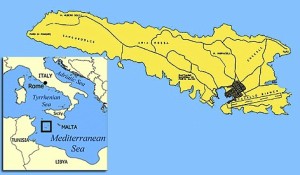- BY Free Movement

Dublin, Italy and the tragedy at Lampedusa
THANKS FOR READING
Older content is locked

A great deal of time and effort goes into producing the information on Free Movement, become a member of Free Movement to get unlimited access to all articles, and much, much more
TAKE FREE MOVEMENT FURTHER
By becoming a member of Free Movement, you not only support the hard-work that goes into maintaining the website, but get access to premium features;
- Single login for personal use
- FREE downloads of Free Movement ebooks
- Access to all Free Movement blog content
- Access to all our online training materials
- Access to our busy forums
- Downloadable CPD certificates
The good name of the greatest city in Ireland, and indeed Europe, has long been sullied by association with the Dublin II Regulation, which followed the original Dublin Convention as the means by which countries unfortunate/fortunate enough to be along the Mediterranean are lumped with the vast majority of asylum seekers who enter Europe [1].
The instability in the Sudan, Syria, Somalia, Eritrea and Libya (to name a few) has driven huge numbers of people to flee towards Europe across the perilous seas, often in vessels that are entirely unsafe. As events in Lampedusa this week have shown, this can have tragic consequences. According to The Australian the numbers of asylum seekers who have entered Italy so far this year is already more than twice last year’s total.
Lampedusa was already notorious by association with the Italian government’s so-called push-back policy. In Hirsi Jamaa and others v Italy [2012] ECHR 1845 the ECtHR found a breach of Article 3 ECHR when refugees fleeing Libya by boat were intercepted by the Italian authorities and brought back to Libya without consideration of their claims, when the instability there was at its height.
As the death toll climbs, Italy has called for more support from the EU and there have been calls from France for a refugee summit. There can be no doubt that as the European Court suggested in Hirsi Jamaa (at §122) and MSS v Belgium and Greece (at §223) the combination of the economic crisis in Europe and the political crisis in North Africa is putting considerable strain on the resources of the south-east European countries.
What has received less airtime since the tragedy is what actually happens to people when they arrive in Italy. What our clients tell us, and the information that comes from NGOs, is grim indeed.

The story is almost universally of refugees and migrants not having access to lawyers or interpreters, and after an initial short period in accommodation becoming homeless and destitute. Generally clients describe living under bridges or in parks during the summer, being fed by local charities and washing in fountains. Then, if they have not already left by winter, many leave Italy taking the opposite route to migrating birds and flock north in search of warmth and shelter. Perversely, it seems that asylum seekers are in many cases treated better than those who are recognised as refugees, as they at least have access to initial housing. The access to shelter and employment mandated by Italian law in practice simply does not happen. There have been recent stories of the Italian authorities giving confused migrants money and telling them to go to Germany.
Some of this has been reported in the press, albeit mostly without great fanfare. The “Palace of Shame”, possibly the largest of the many squats in Rome, was visited by the European Commissioner for human rights where he found 800 “beneficiaries of international protection”:
“During his stay in Rome, the Commissioner visited an abandoned university building in the south-eastern periphery of the city, occupied by recognised refugees or other beneficiaries of international protection from Sudan and the Horn of Africa. This derelict, eight-storey building, called “Selam Palace” by its inhabitants, and nicknamed “Palace of Shame” (Palazzo della vergogna) by NGOs and in the media, was housing an estimated 800 people at the time of the visit. The Commissioner witnessed the shocking conditions in which the men, women and children were living in this building, such as one shower and one toilet shared by 250 persons.”
Some of our clients tell us that the opportunity to live in these “shocking conditions” is actually highly prized by many migrants in Italy because the alternative is living in a park. It is of course entirely unsurprising that many of our clients’ accounts include violence, racist or otherwise, and sexual assault.
Against this background there have been many cases challenging the removal of asylum seekers and refugees to Italy.
The pattern will be very familiar to those who were involved in the Greek cases which finally, after years of challenges and failures, culminated in the ECtHR deciding that returning an asylum seeker to Greece would result in a breach of Article 3 ECHR in MSS v Belgium and Greece [2011] ECHR 108. Challenges to Dublin II removals are bitterly contested by the Home Office and Courts are extremely reluctant to find a fellow EU State is in breach of its obligations even as the evidence continues to mount.
The current challenge to the lawfulness of removals to Italy (technically a challenge to the certification of the human rights claims of the people involved as “clearly unfounded”) is to be heard in the Supreme Court in early November, with UNHCR intervening. This is the appeal from the decision of the Court of Appeal in EM (Eritrea) v SSHD [2012] EWCA Civ 1336 and is a hugely important case.
In EM (Eritrea) the Court of Appeal had held that the individuals in question had demonstrated an arguable risk of a breach of Article 3 ECHR such that their claims could not be certified… or would have done, but for the decision of the CJEU in NS v SSHD [2011] CJEU C-411/10 which had set a “new threshold” for a breach of Article 3 ECHR in the Dublin II context, one which “exists nowhere else in refugee law”. NS (according to the Court of Appeal) required that an Article 3 risk could only arise in the Dublin II context because of reception conditions where there was a “systemic deficiency”, and short of this even “powerful evidence of individual risk” was of no avail. The finding, in effect, was that the CJEU had changed the definition of Article 3 for Dublin cases.
However, the European Court in the case of Mohammed Hussein v Netherlands and Italy (27725/10) has now recently held that an Article 3 ECHR case against removal to Italy under the Dublin procedures was “manifestly ill-founded”, accepting (surprisingly, and disappointingly) without demur the Italian authorities’ bland assertions as to the availability of resources to refugees and asylum seekers.
Already Courts in other Member States are refusing to follow Mohammed Hussein. As was the case when in KRS v United Kingdom [2008] ECHR 1781 the ECtHR held that challenges to removal to Greece were manifestly ill-founded, the Administrative Court in Frankfurt Am Main has refused to follow Mohammed Hussein on the basis that it simply does not reflect the evidence. The legal reasoning in Mohammed Hussein meanwhile, suggests that the approach in EM (Eritrea) of excluding evidence of individual risk was entirely wrong.
We will at least know what the proper legal approach to Article 3 Dublin cases is following the decision of the Supreme Court. In the meantime, the factual case against Italy continues to build as more and more migrants risk their lives to get there.
[1] How come Ottawa got the Treaty on landmines? And why did Geneva get the Refugee convention? Who decides these things?
SHARE


5 responses
I think part of the issues the refugees are facing in Italy is that the it doesn’t really have a benefit system comparable with those of countries such as the UK or the Scandinavian ones. Italy does spend a similar amount of Britain in social protections, but that’s heavily geared towards people who had previously worked and paid tax and contributes. Young Italians or long term jobless Italians are facing similar if not same conditions of the refugees.
Mohammed Hussein v Austria… I think you mean The Netherlands and Italy.
Yes, was obviously thinking of Mohammed v Austria. Will change.